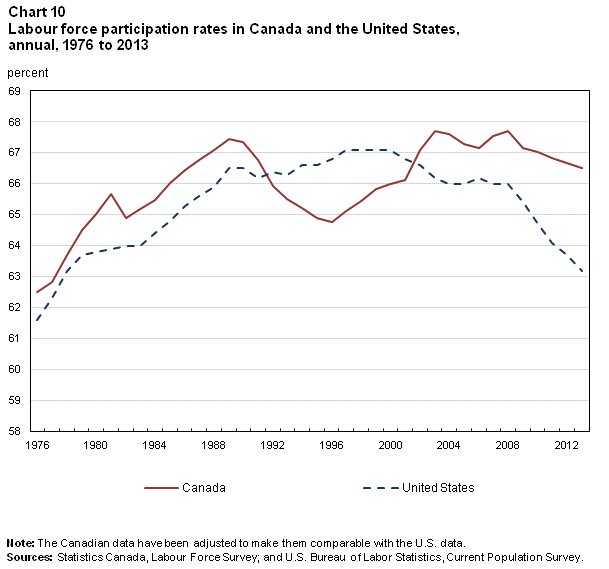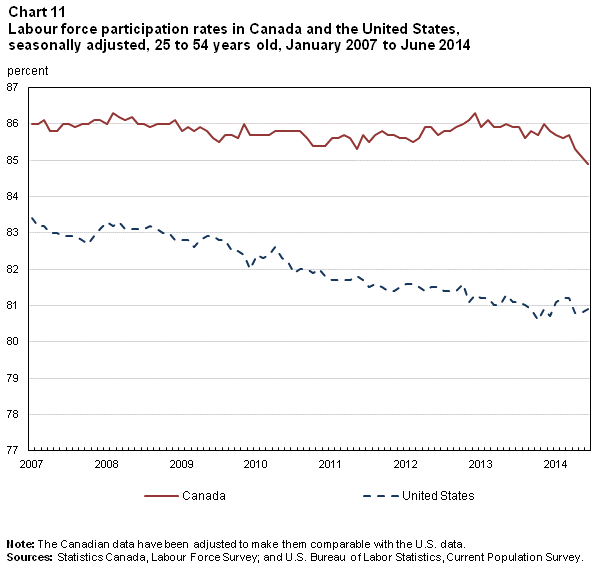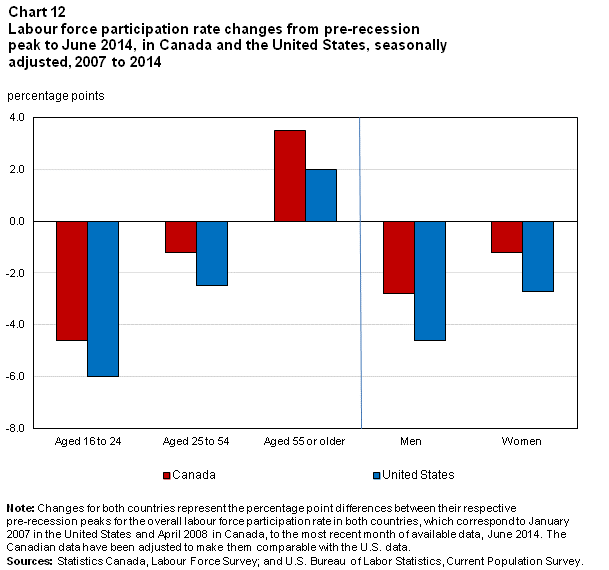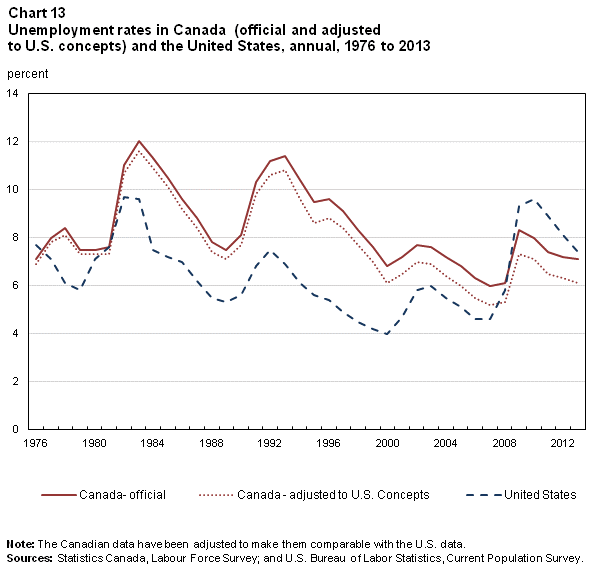Publications
Economic Insights
The Labour Market in Canada and the United States Since the Last Recession
The Labour Market in Canada and the United States since the Last Recession
Archived Content
Information identified as archived is provided for reference, research or recordkeeping purposes. It is not subject to the Government of Canada Web Standards and has not been altered or updated since it was archived. Please "contact us" to request a format other than those available.
by André Bernard, Analytical Studies Branch and Jeannine Usalcas, Labour Statistics Division
July 2014

Start of text box
This Economic Insights article reports on recent labour market trends in both Canada and the United States since the last recession. The data for Canada come from Statistics Canada’s Labour Force Survey (LFS), while those for the United States come from the Current Population Survey (CPS), a survey produced for the Bureau of Labor Statistics. For the purposes of comparison, the Canadian data have been adjusted to follow the concepts used in the United States. Unless indicated otherwise, the data for both countries are monthly and are seasonally adjusted.
End of text box
Given the integrated nature of the U.S. and Canadian economies, cyclical fluctuations in the United States tend to have an impact on economic activity in Canada. Comparisons between the Canadian and U.S. labour markets, therefore, generate a high level of interest.Note 1 In fact, although the impact of U.S. economic downturns on the Canadian economy has varied greatly from case to case, previous recessions in both countries have often been synchronized (Cross 2009).
In the United States, the recession that started in December 2007Note 2 had a profound impact on the U.S. labour market, and has been described as the most severe recession of the post-war period (Elsby, Hobijn and Sahin 2010). In Canada, the 2008–2009 recession also resulted in considerable job losses, but has been less severe than recessions that started in 1981 and in 1990 (Cross 2011). After the recession, employment growth in both countries followed an upward trend. However, the rate of growth was not steady, and average monthly employment growth in both countries was slower in 2013 than in 2012.
In Canada, information on the current state of the labour market is collected through Statistics Canada’s Labour Force Survey (LFS). In the United States, household labour market information is taken from the Current Population Survey (CPS), a survey conducted for the Bureau of Labor Statistics.Note 3 Both are monthly surveys that use largely similar methodologies. The LFS sample is approximately 56,000 households, while the sample for the CPS is approximately 60,000 households.
There are, nonetheless, some conceptual differences between the two surveys. Therefore, adjustments are made to the Canadian data to make them coherent with the U.S. concepts, so that the data from the two countries can be compared (Sunter 1998; Usalcas and Bowlby 2002; Ferrao 2009; Zmitrowicz and Khan, 2014). These adjustments are presented in the appendix.
Adjustments made to the data can affect their interpretation. For example, if the unemployment rates of the two countries were to be compared without taking these adjustments into account, the U.S. unemployment rate would have fallen below the Canadian rate in December 2013, after being higher the previous five years. In reality, Canada’s unemployment rate in that month, adjusted for the purposes of comparison with the U.S. rate, was still 0.6 percentage points lower than the U.S. rate.
In this article, a set of indicators for the pre-recession period up to June 2014 is compared, to obtain a comparative profile of the state of the labour market in both countries. The indicators presented are employment, the employment rate, the unemployment rate, and the participation rate. All of the Canadian data have been adjusted to the U.S. concepts, to allow for direct comparisons.
Decline in employment more severe in the United States than in Canada during the last recession
Although the last recession led to significant employment losses in both countries, employment losses in the United States were larger - even after accounting for the differences in the size of the two economies - and extended over a longer period of time than losses in Canada.
In Canada, employment adjusted to U.S. concepts contracted by 400,000 jobs from peak (October 2008) to trough (July 2009)—a 2.3% decline over nine months.Note 4 By comparison, employment in the United States contracted by 8.6 million from peak (November 2007) to trough (December 2009)—a 5.9% decrease over a 25-month period (Chart 1).

Employment growth in both countries slowed in 2013, but increased in the United States in early 2014
In Canada, the decline of 400,000 in employment during the downturn was regained in the 16 months from July 2009 to November 2010. Employment then continued an upward trend, increasing on average by 15,900 workers each month until June 2014—an average monthly increase of 0.1%. However, the pace of employment growth has not been steady. Average monthly employment growth was 26,000 in 2012, before slowing to 8,900 in 2013, and to 7,100 in the first six months of 2014.
In the United States, employment expanded on average by 152,000 per month from the low in December 2009 until June 2014, a pace that was proportionally similar to that of Canada. In June 2014, the number of employed individuals in the United States was, therefore, close to, but still below the peak it reached in November 2007.
As in Canada, growth in the United States accelerated in 2012, before slowing in 2013. Employment increased by an average of 115,000 during each month of 2013 in the United States, as compared with 198,000 during 2012. However, employment growth strengthened during the first six months of 2014, at an average increase of 273,000 each month.
Employment growth similar to working-age population growth in both countries
The employment rate corresponds to the percentage of the working-age population that is employed. It allows the interpretation of employment growth in relation to population growth. Employment growth that is greater than population growth can be indicative of an improvement in the state of the labour market. The employment rate increases (decreases) when employment growth is higher (lower) than working-age population growth.
In Canada, the employment rate, adjusted to U.S. concepts, declined during the 2008–2009 recession, falling from a historic high of 64.4%, in February 2008, to a cyclical low of 62.0% in July 2009 (Chart 2). The July 2009 employment rate was the lowest since March 2002.

Since then, the rate has changed little, and stood at 62.0% in June 2014. The stability of Canada’s employment rate since 2009 indicates that the rate of employment growth has not surpassed working-age population growth.
In the United States, the employment rate decreased from a cyclical high of 63.3%, in March 2007, to a low of 58.2%, in November 2010, the lowest employment rate observed since 1983. This decline in the employment rate was more significant than in the previous three recessions, and was more than double the corresponding decline in Canada. Subsequently, the employment rate in the United States did not change much. As in Canada, employment growth in the United States since 2010 was, therefore, similar to the growth of the working-age population.
It is not unprecedented for Canada to have a declining employment rate during a recession, followed by stability at relatively low levels. During the 1990–1992 recession, the employment rate in Canada declined sharply, and remained relatively low for much of the 1990s, before beginning to trend upward (Chart 3). It was not until the end of 2002 that the employment rate returned to its pre-recession level. For this reason, the employment rate was lower in Canada than in the United States, throughout the 1990s until the end of 2002.

The employment rate in the United States trended downward over the 2000 to 2004 period and during the last recessionNote 5, while, in Canada, it continued to trend upward until the start of the last downturn. Because of these diverging trends, the employment rate in Canada has remained above the rate in the United States since November 2002.
The most significant declines in the employment rate in both countries since the recession were recorded among youth
In both countries, declines in employment rates since the last recession were more significant for youth than for any other age group (Chart 4). In Canada, from the pre-recession peak of February 2008 until June 2014, the employment rate among youth, aged 16 to 24, fell by 5.0 percentage points to 58.7%. Over the same period, the employment rate among adults, aged 25 to 54, declined 2.0 percentage points to 80.6%.

In the United States, from its pre-recession peak of March 2007 to June 2014, the youth employment rate fell 6.6 percentage points to 47.5%, while it declined 3.5 percentage points to 76.7%, among individuals aged 25 to 54.
In both countries, the decline in the employment rate in recent years has been more significant for men than for women.
The employment rate for Americans aged 55 and over did not trend downward during or after the recession, while the rate for their Canadian counterparts rose, reaching a record high in June 2014. This finding is consistent with recent trends suggesting the postponement of retirement among older workers (Galarneau and Carrière, 2012).
The unemployment rate more than doubled in the United States during the last recession
Since employment losses were greater in the United States than in Canada, the increase in the unemployment rate during the recession was more substantial in the United States (Chart 5). The increases in both countries were significant for all age groups (Charts 6 and 7).



In August 2008, Canada’s unemployment rate, adjusted to U.S. concepts, was at its lowest level since 1976, at 5.1%. In the wake of the recession, the unemployment rate rose by 2.6 percentage points to 7.7%, in July 2009. It then decreased gradually over the following four years. In the United States, the unemployment rate more than doubled during the downturn, from 4.4% in May 2007 to 10.0% in October 2009, before beginning to decline.
Unemployment rate higher in the United States than in Canada since 2008, but the gap has closed
The unemployment rate in the United States was higher than in Canada from May 2008 to May 2014. This contrasted with historic patterns where the U.S. unemployment rate remained consistently lower than that of Canada since the early 1980s (Chart 8).

In November 2010, the difference between the unemployment rates in the United States and in Canada was 3.1 percentage points—the largest difference in Canada’s favour recorded since 1976. The gap between the two unemployment rates then gradually narrowed, as the decline in the unemployment rate in the United States was more rapid than the decline in Canada. In June 2014, the two unemployment rates were identical, at 6.1%. (Chart 5)
The decline in labour force participation has been driving the decline in the unemployment rate in recent years, in both countries
As employment growth did not outpace working-age population growth, declining unemployment rates in Canada and the United States, over the past four years, have been largely driven by declines in labour force participation. The participation rate—the percentage of the working-age population that is employed or looking for work—has declined, in both countries, since the beginning of the last downturn. The decrease in the participation rate has been more pronounced in the United States than in Canada, which helps explain the larger decrease in the unemployment rate in the United States as compared with Canada in recent years (Chart 9).

In Canada, the participation rate adjusted to U.S. concepts was at its pre-recession peak in April 2008, at 67.9%. The rate has since declined to 66.0% as of May and June 2014. This was the lowest participation rate in Canada since August 2001.
In the United States, the participation rate was 66.4% in January 2007, before declining 3.6 percentage points to June 2014. The U.S. participation rate stood at 62.8% in June 2014, for the fifth time in the past nine months, the lowest level since March 1978.
Since 2002, labour force participation has been higher in Canada than in the United States (Chart 10). In recent years, the larger decrease in the U.S participation rate has widened the gap between the rates in the two countries, which was 3.2 points in favour of Canada in June 2014 (Chart 9).

Labour force participation down among prime-age workers in the United States
Because the share of older workers in the working-age population has increased over time and older workers tend to have lower participation rates, an aging population in both countries can put significant downward pressure on the overall labour force participation rate (Janzen, 2014, Zmitrowicz and Khan, 2014). Trends in labour force participation rates among prime-aged workers are informative in that they are less likely to be affected by population aging (Zmitrowicz and Khan, 2014).
In Canada, the participation rate among prime-age workers, aged 25 to 54, remained relatively stable during and after the recession, before declining 1.1 percentage points to 84.9% from November 2013 to June 2014. In the United States, the decline in the participation rate was larger and more gradual. At 80.9% in June 2014, it was 2.5 percentage points lower than it was in January 2007 (Chart 11).

In both countries, labour force participation was down among youth and up among older workers
In Canada, as in the United States, the labour force participation of youth has declined significantly, while that of older workers has in fact increased (Chart 12).

In Canada, from the pre-recession peak of April 2008 until June 2014, the participation rate among youth, aged 16 to 24, fell by 4.6 percentage points to 66.8%. Conversely, the participation rate for those aged 55 and over increased over the same period, from 34.0% to 37.5%.
A similar phenomenon has been observed in the United States. From the pre-recession high of January 2007 until June 2014, the participation rate among Americans aged 16 to 24 fell from 60.7% to 54.7%. During that time, workers aged 55 and over recorded an increase in their participation rate, from 38.0% to 40.0%.
In Canada, as in the United States, men contributed more than women to the decline in the overall participation rate since the last recession. In Canada, from April 2008 until June 2014, the participation rate among men fell 2.8 percentage points to 70.5%, while it declined 1.2 percentage points to 61.5% among women. In the United States, from January 2007 to June 2014, men's participation rate fell 4.6 percentage points to 69.2% while women's participation rate declined by 2.7 percentage points to 56.8%.
Summary
This article has presented a set of indicators on the state of the labour market in Canada and in the United States, from the pre-recession period up to June 2014. The Canadian data has been adjusted to make them directly comparable with U.S. data. Through comparative analysis, a number of similarities and differences between the two countries have been identified.
The last recession resulted in more severe employment losses in the United States than in Canada. Proportionally, employment losses in the United States were more than double those in Canada, and lasted longer.
Since then, employment in both countries has increased at approximately the same rate, and has not exceeded the rate of growth of the working-age population. Accordingly, the employment rate remains below the pre-recession level in both countries. Since the beginning of 2014, however, employment growth has been higher in the United States than in Canada.
Since the end of the recession, the unemployment rate in both countries has declined, but the decreases have been largely driven by decreases in labour force participation. The decline in the participation rate in the United States has been more pronounced than in Canada, notably among prime-age workers. Therefore, the decrease in the unemployment rate has been more pronounced in the United States. Although Canada’s unemployment rate had been lower than that of the United States since May 2008, the gap between the rates has now closed.
Appendix: adjustments to Canadian data
This section details the adjustments that must be made to the Canadian data from the Labour Force Survey (LFS) to make them directly comparable with the U.S. data from the Current Population Survey (CPS).
First, those aged 15 must be removed from the LFS, as they are not surveyed in the CPS. This change affects both the employed and unemployed populations.
The other changes affect only the unemployed population. Three groups of people, considered unemployed in Canada, are deemed to not be participating in the labour force in the United States: (1) people who were looking for work, but who looked only at job ads; (2) people who had not looked for work, but who reported that they had a job that would start in the next four weeks; and (3) people who had reported that they were not available to work because of personal or family responsibilities. These three groups of people were, therefore, removed from the unemployed population in the LFS, and were added to the population of people not participating in the labour force.
Conversely, full-time students who report that they are looking for full-time work are not considered participants in the labour force in Canada, but are considered to be part of the unemployed population in the United States. These people were, therefore, removed from the population that was not participating in the labour force in the LFS, and were added to the unemployed population.
When these adjustments are made, the unemployment rate is generally lower than the headline rate published by Statistics Canada (Chart 13), while the employment rate is generally higher than official estimates. The magnitude of these differences can vary over long periods of time. On average from 2007 to 2013, the difference between the adjusted and unadjusted unemployment rates was 0.9 percentage points while the difference between the adjusted and unadjusted employment rate was 0.7 percentage points. In recent years, there has generally been little difference between the adjusted and unadjusted Canadian participation rates.

References
Cross, Philip. 2009. “The impact of recessions in the United States on Canada.” Canadian Economic Observer. Catalogue No. 11-010. Statistics Canada. March.
Cross, Philip. 2011. “How did the 2008-2010 recession and recovery compare with previous cycles?” Canadian Economic Observer. Catalogue No. 11-010. Statistics Canada. January.
Elsby, Michael W, Bart Hobijn and Aysegul Sahin, 2010. The Labor Market in the Great Recession. NBER Working Paper 15979, National Bureau of Economic Research, Cambridge. May.
Ferrao, Vincent. 2009. “The recent labour market situation in Canada and the United States.” Perspectives on Labour and Income, Catalogue No. 75-001. Statistics Canada. March.
Galarneau, Diane and Yves Carrière. 2012. “How many years to retirement?” Insights on Canadian Society. Catalogue No. 75-006. Statistics Canada. December.
Janzen, Nathan. 2014. “What explains the decline in Canada's labour force participation rate?” RBC Economics Research, May.
Karabegovic, Amela, Nachum Gabler and Niels Veldhuis. 2012. Measuring Labour Markets in Canada and the United States. 2012 Edition. Fraser Institute. September.
LaRochelle-Côté, Sébastien and Jason Gilmore, 2009. “Canada’s Employment Downturn.” Perspectives on Labour and Income, Catalogue No. 75-001. Statistics Canada. December.
Moffitt, Robert A. 2012. The U.S. Employment-Population Reversal in the 2000s: Facts and Explanations. National Bureau of Economic Research, Working Paper No. 18520. November.
Sunter, Deborah. 1998. "Canada - US Labour Market Comparison" Canadian Economic Observer, Catalogue No. 11-010. Statistics Canada. December.
Usalcas, Jeannine and Geoff Bowlby, 2002. "The Labour Market: Up North, Down South" Perspectives on Labour and Income, Catalogue No. 75-001 Statistics Canada. December.
Zmitrowicz, Konrad and Mikael Khan. 2014. "Beyond the Unemployment Rate: Assessing Canadian and U.S. Labour Markets Since the Great Recession" Bank of Canada Review. Spring.
Notes
- Date modified:
